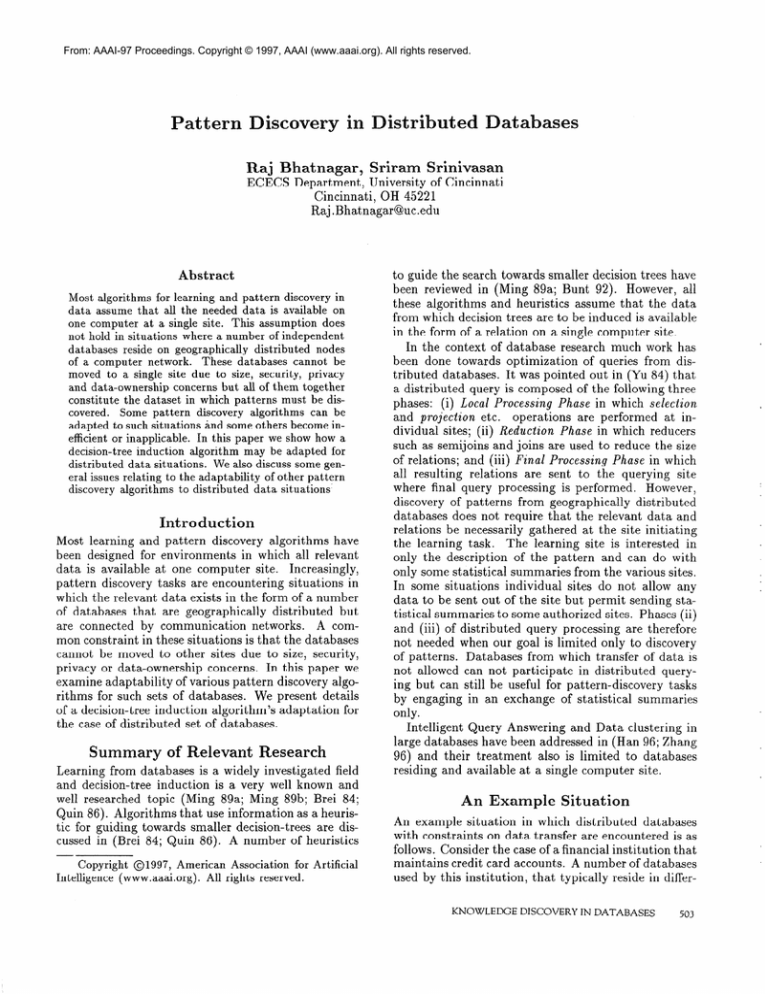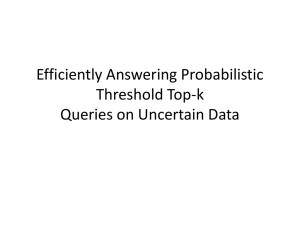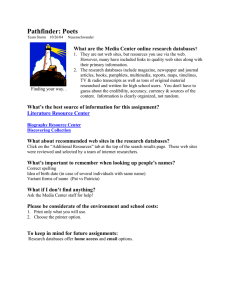
From: AAAI-97 Proceedings. Copyright © 1997, AAAI (www.aaai.org). All rights reserved.
iscovery i
Pattern
Raj
ECECS
Bhatnagar,
Most
algorithms
for learning
and pattern
discovery
in
data
assume
that
all the needed
data is available
on
one computer
at a single
site.
This
assumption
does
not hold in situations
where
a number
of independent
databases
reside
on geographically
distributed
nodes
of a computer
network.
These
databases
cannot
be
moved
to a single
site due to size, security,
privacy
and data-ownership
concerns
but all of them
together
constitute
the dataset
in which
patterns
must
be discovered.
Some
pattern
discovery
algorithms
can be
adapted
to such situations
&nd some others
become
inefficient
or inapplicable.
In this paper
we show
how a
decision-tree
induction
algorithm
may be adapted
for
distributed
data situations.
We also discuss
some general issues relating
to the adaptability
of other
pattern
discovery
algorithms
to distributed
data situations
Introduction
Most learning
and pattern
discovery
algorithms
have
been designed
for environments
in which all relevant
data is available
at one computer
site. Increasingly,
pattern
discovery
tasks are encountering
situations
in
which the relevant data exists in the form of a number
of databases
that are geographically
distributed
but
are connected
by communication
networks.
A common constraint
in these situations
is that the databases
cannot be moved to other sites due to size, security,
privacy or data-ownership
concerns.
In this paper we
examine adaptability
of various pattern
discovery algorithms for such sets of databases.
We present details
of a decision-tree
induction
algorithm’s
adaptation
for
the case of distributed
set of databases.
of Relevant
Research
Learning
from databases
is a widely investigated
field
and decision-tree
induction
is a very well known and
well researched
topic (Ming
89a; Ming 89b; Brei 84;
Quin 86). Algorithms
that use information
as a heuristic for guiding
towards smaller decision-trees
are discussed
in (Brei
84; Quin
86).
A number
of heuristics
Copyright
Intelligence
@199’7,
(www.aaai.org).
American
All
Sriram
at abases
Srinivasan
Department,
University
of Cincinnati
Cincinnati,
OH 45221
Raj .Bhatnagar@uc.edu
Abstract
Summary
istributed
Association
for
rights
reserved.
Artificial
to guide the search towards smaller decision trees have
been reviewed
in (Ming
89a; Bunt 92). However,
all
these algorithms
and heuristics
assume that the data
from which decision trees are to be induced is available
in the form of a relation
on a single computer
site.
In the context of database
research much work has
been done towards optimization
of queries from distributed
databases.
It was pointed
out in (Uu 84) that
a distributed
query is composed of the following
three
phases: (i) Local Processing
Phase in which selection
and projection
etc. operations
are performed
at individual
sites; (ii) Reduction
Phase in which reducers
such as semijoins
and joins are used to reduce the size
of relations;
and (iii) Final Processing
Phase in which
all resulting
relations
are sent to the querying
site
where final query processing
is performed.
However,
discovery
of patterns
from geographically
distributed
databases
does not require that the relevant
data and
relations
be necessarily
gathered
at the site initiating
the learning
task.
The learning
site is interested
in
only the description
of the pattern
and can do with
only some statistical
summaries
from the various sites.
In some situations
individual
sites do not allow any
data to be sent out of the site but permit sending statistical summaries
to some authorized
sites. Phases (ii)
and (iii) of distributed
query processing
are therefore
not needed when our goal is limited
only to discovery
of patterns.
Databases
from which transfer
of data is
not allowed can not participate
in distributed
querying but can still be useful for pattern-discovery
tasks
by engaging
in an exchange
of statistical
summaries
only.
Intelligent
Query Answering
and Data clustering
in
large databases have been addressed in (Han 96; Zhang
96) and their treatment
also is limited
to databases
residing and available
at a single computer
site.
An
Example
Situation
An example
situation
in which distributed
databases
with constraints
on data transfer are encountered
is as
follows. Consider the case of a financial
institution
that
maintains
credit card accounts.
A number of databases
used by this institution,
that typically
reside in differKNOWLEDGE
DISCOVERY
IN DATABASES
503
ent cities, are: (i) A database
containing
fixed data
about customers
such as employer
and address information; (ii) A database of credit card charges and payments made by the customer;
(iii) A database containing information
about vendors
that accept the card;
and (iv) A database containing
credit-rating
information about customers.
The above scenario
comes with the following
constraints:
The databases
or smaller
relations
extracted
from
them cannot be transferred
from their home sites
due to security,
size, data ownership
and privacy
concerns.
Each database is designed and maintained
independently and therefore
the databases,
collectively,
do
not generally
constitute
a normalized
set of relations.
Over time, different
databases may become available
and be added to the set from which patterns
are
to be discovered
and some older databases
may be
dropped.
Some attributes
are repeated
in various
databases.
The databases are write-protected
in the sense that
an agent from outside
their respective
sites is not
permitted
to write to a database.
The queries permitted
to non-local
but authorized
agents are those that return
statistical
summaries
from the databases.
No actual data tuples can be
transmitted
out of any site.
Similar
constraints
exist on many commercial,
financial, and defense related databases.
Despite these constraints it is possible to discover patterns
in the collective dataset and we demonstrate
it in this paper.
Formal
A pattern
Description
discovery
1. A set of tuples
2. A Pattern
task requires
D representing
discovery
of Problem
the following:
the data.
Agents
Network
1: Databases
The case of distributed
databases
and their associated constraints
can be represented
as shown in Figure1. We have n databases
located at n different
nodes
of a network.
We model each database site by a relation present at that site and Figure-l
shows relation
di at the ith site. Each database
di is represented
by
504
LEARNING
Sij = Ai
n Aj
(1)
The dataset D in which patterns
are to be discovered is a subset of that set of tuples which would be
generated
by a Join operation
performed
on all the
relations
dl . . . d,. However,
the tuples of D cannot
be made explicit
at any one site because data from dis
cannot be transferred
to other sites. The tuples of D,
therefore,
must remain
only implicitly
defined.
This
inability
to make explicit
the individual
tuples of D
is the most severe limitation
of the constrained
set of
databases.
To facilitate
pattern
discovery
in the implicitly
defined set of tuples of D we define a set S that is the
union of all the intersection
sets defined above. That
is,
S = Ui,j , i#j
Sij
(2)
The set S contains
all those attributes
that occur in
more than one di . We also define a new relation
Share& containing
all the attributes
in set S. The tuples in Share& are formed by enumerating
all possible
combinations
of values for attributes
in set S.
Pattern
Discovery
Task
A pattern discovery
task for distributed
databases
be performed
in one of the following
ways:
can
1. Transfer
all relevant
relations
to a single site and
perform
a Join operation
to create a single relation.
Then run the pattern
discovery
algorithm
using this
single table.
algorithm.
Databases
Figure
an agent Ci that obtains summaries
from its database
and exchanges
them with agents for other databases.
Each agent is capable of initiating
and completing
a
pattern
discovery
task by exchanging
summaries
with
other agents.
The set of attributes
contained
in relation
di is represented by Ai. Our discussion in this paper is limited to
databases
containing
nominal
valued attributes
only.
For any pair of relations
di and dj the corresponding
sets Ai and Aj may have a set of shared attributes
given by Sij. That is,
2. Decompose
the computations
of the pattern
discovery algorithm;
perform
the decomposed
parts at individual
database sites; transmit
the results back to
the site performing
discovery5 and then compose the
responses from individual
sites to create the result.
For our constrained
situation
the first option
is
clearly ruled out. We must devise decompositions
of
pattern
discovery algorithms
such that the results produced are identical
to those that would have been obtained by the first option.
The decomposed
versions
would have to work as follows:
1. Learning
task is initiated
at a site called Learner
which can be any one of the n database
sites as
shown in Figure-l,
or possibly
any other authorized
site.
Attribute
names in all the Ai sets, and as a consequence the relation
Share&
are known to the site
initiating
the pattern
discovery
task.
The learner site sends requests to various
statistical
summaries
about their respective
The learner site composes
responses
sites and constructs
the descriptions
patterns.
sites for
dg.
from various
of discovered
To demonstrate
the decomposability
of pattern
discovery algorithms
and computations
we select a simple decision-tree
induction
algorithm
and present an
adaptation
for all its steps for the case of constrained
distributed
databases.
We briefly
describe
some aspects of the decision tree-induction
algorithm
here even
though it is a well known algorithm.
We do so to facilitate easy reference and comparison
with the adapted
version of the algorithm.
Decision-Tree
Induction
the tree as small as possible.
A heuristic
that is used
to keep the height of the tree on the smaller side selects
that attribute
ai in Step-2 which minimizes
the average
informational
entropy of the partitions
formed in step3. The value of this average entropy
is computed
as:
Algorithm
(3)
where Nb is the number of tuples in branch b, Nt is the
total number of tuples in all branches,
c is the number
of possible classes (the values the target attribute
can
possess), and N bc is the number of tuples in branch b
belonging
to class c. The attribute
that minimizes
the
average entropy for the resulting
partitions
is chosen.
Adaptation
for Implicit
Tuple
Space
The tree induction
algorithm
described
in the above
section requires an explicit
set of tuples at each node
of the tree. This set is used for the following:
1. Computation
of entropy
2. Testing to determine
to the same class.
after partitioning
if all tuples
a dataset.
in a dataset
belong
In case of the constrained
distributed
databases an explicitly
stated set of tuples is not available.
Each step
of the induction
algorithm
must adapt itself to work
with the implicitly
specified
set of tuples.
In the following section we consider various aspects of the tree
induction
algorithm
and present the version adapted
for the implicit
set of tuples.
Figure
2: Building
a Decision
Tree
Various tree induction
algorithms
including
ID3 and
others (Brei 84; Quin 86) start by considering
the complete dataset D belonging
at the root of the tree and
then repeating
the following
steps until all or a large
majority
of tuples at each leaf node of the tree belong
to some unique class (Value of the Target-Attribute).
1. Pick one such dataset at a leaf node a majority
of
whose tuples belong to different
classes. (By datuset
here we are referring
to any set of tuples belonging
to a node of the decision tree.)
2. Select
Ujl,
CLj2..
an attribute
. Ujm.
aj
3. Split D into m distinct
partition
contains only
having
m
distinct
values:
partitions
such that the L?
those tuples for which aj =
ajk.
4. The m distinct
partitions
are added to the tree
as child datasets of the partitioned
parent dataset.
These child nodes reside at the end of m branches
emanating
from the parent node.
Figure-2
shows how the above
construct
the tree. It is desirable
steps are repeated
to keep the height
to
of
Characterization
of a set of tugles:
When
a
dataset is known explicitly
it can be stored as a table in computer
memory.
After repeated
partitionings,
smaller datasets belonging
to leaf nodes of the tree can
be represented
by storing
a partition
identity
number
along with each tuple in an additional
column of the
relation.
When the dataset is only implicitly
specified
there
does not exist any facility
to store identities
of partitions to which individual
tuples belong.
Description
of
every partition
must also be implicit.
For the case of
decision trees the conjunction
of tests performed
along
a path is the implicit
description
of the dataset at the
end of that path. Clustering
and pattern
discovery algorithms
that rely on marking
each tuple with their
cluster-id
as they progress will not be able to work in
the constrained
environment.
Selecting
the Attribute:
In step 2 of the algorithm
we choose an attribute
and use it to partition
the selected parent dataset into its children
datasets.
The
attribute
that minimizes
the average informational
entropy is considered
the most promising
one and is selected.
The expression
for entropy
computation
requires the values of the following
counts from the parent dataset:
1. N,;
KNOWLEDGE
DISCOVERY
IN DATABASES
505
2. one Nb for each child
branch;
and
3. one Nb, for each
class for each child branch.
When the tuples are explicitly
stated an d stored in a
For the case
table these counts can easily be obtained.
of implicitly
stated set of tuples we have decomposed
the counting
process in such a way that each decomposed part can be shipped
to an individual
database
site and the responses
composed
to reconstruct
the
counts. The decomposition
for obtaining
the count Nt
is as follows:
(5)
J
where
subscript
count
sub1
Jsl
t=l
[Sl = S~J,~],
[S2 =
In this
expression
=
%Jsk].
3Js2]
. . ., [Sk
Sl, s2,. . . Sic are the k members
of set S defined
by expression
2 above; Jsi , Js2, . . . Jsk are the numbers of possible
discrete
values
that
can be assigned to attributes
Sl, S2, . . . Sk
respectively;
and
are all the values that can be assil
, sip,
. . . SiJ,,
signed to attribute
Si. The value n is the number
of
database sites (dis) to be considered,
and (N(dt),,bi)
is the count in relation
dt of those tuples that satisfy
the conditions
stated in subscript
subl.
for Nt is in the
It can be seen that the expression
sum- of-p roducts form. Each term in the product
is the
count of tuples satisfying
condition
sub1 in a di. The
resulting
product
produces
the number
of distinct
tuples that would be contributed
to the imagined
Join of
all dis for the sharing condition
specified by subl. The
relation
Shareds
contains tuples specifying
all the different ways dis can have shared attribute
values. The
summation
in the above expression
picks up each tuple
of the relation
Shareds
as value for the sub1 and sums
up the product
terms obtained
for each subl.
This expression,
therefore,
simulates
the effect of a
Join operation
on all the n sites without
enumerating
the tuples. The simulation
only computes the count of
tuples that would exist in various partitions
of D.
k very desirable
aspect of the particular
decomposition of Nt given above is that each product
term
(N(dt)subl)
can also be easily translated
into an SQL
query of the form:
Select
the
J s2
is:
(*) w h ere desired-partition
and sub1
and shipped to the site containing
relation
dt. The expression
desired-partition
above states the conditions
along the decision tree path leading up to the dataset
being partitioned.
For each tuple in relation
Shareds
we have to send the above query to each of the n
database
sites. The responses can then be multiplied
to obtain a product-value
for a tuple, and the productvalues for all the tuples of Shareds
can be summed to
obtain the value Nt.
The decompositions
for the counts Nb and Nbc are
similar to that for Nt. The expressions
are stated as
follows:
506
LEARNING
t=3
Jsl
= IS1 =
sub2 is:
sub2
. , [Sk = SkJsk], [B = BJ,].
The
expression
for Nb differs from that for Nt by containing an additional
summation
over the partitioning
attribute
B and the corresponding
addition
to the condition part of the product
term.
where
the
slJsl],
[3
subscript
=
s2Js2]-.
Nt=c -..c ~(fi(N(dt),ual)) (4)
J sk
J s2
sk
.
J sk
J 92
Jsl
t=l
where
the subscript
sub3 is: [Sl = Sl J,~],
[S2 =
. , [Sk = SkJsk], [B = BJ&
[C = CJ,].
The
expression
for Nbc differs from that for Nb by containing an additional
summation
over the target attribute
C and the corresponding
addition
to the condition
part
of the product
term.
The counts Nt , Nb, and Nbc can be composed
by
obtaining
responses from individual
databases
in the
manner described
above and the the entropy
value for
each proposed
partitioning
can be determined.
=Js2]
1) .
Splitting
A Dataset:
After deciding
to partition
a
dataset into its children
datasets (Step-3)
the learning
site needs only maintain
the decision tree constructed
so far. At the learning
site a marking
can be maint ained for each leaf node indicating
all its tuwhether
ples belong to only one or more classes. This can be
determined
by examining
various
Nbc counts at the
time of creating
the children
datasets.
Handling
Exception
Tuples:
The method
described above creates an implicit
tuple space which is
equivalent
to the cross-product
obtained
from the n explicitly
known relations
di, . . . , d,. All tuples formed
in this implicit
space may not be valid data combinations.
Those tuples known
to be unacceptable
combinations
can be excluded
from consideration
by the
above decomposed
algorithm
as follows.
The learning
site maintains
a relation
called Exceptions
containing
all the attributes
of the n datasets.
All known unacceptable tuples are stored in this relation.
The product
terms in the decompositions
for Nt , Nb, and Nbc can
be modified
to discount
the matching
tuples found in
the relation
Exceptions.
That is, the decomposition
for
Nt would become:
Nt = ~...~~(
J sk
where NeXC,,bl
ceptions that
J s2
(N(dt),,t,l) - NeXCsubl)(7)
Jsl
t=l
is the number oft uples in relation
match the condition
subl.
Ex-
Complexity
The cost of working
with
of tuples can be measured
an implicitly
specified
set
in various ways. One cost
model computes the number of messages that must be
exchanged among various sites. Complexity for distributed query processing in databases has been discussed in (Wang 96) and the cost model used is total
data transferred for answering a query. In our case the
amount of data transferred in each message is very little (statistical summaries etc.) but it is the number
of messages to be exchanged that grows rapidly. We
derive below an expression for the number of messages
that need to be exchanged for dealing with the implicit
et of tuples.
The exchange of messages occurs predominantly for
computing the entropy values. An estimation of the
number of messages exchanged while computing entropy values can be obtained as follows. Let us say:
o There are n relations,
ent network sites.
di . . . d n, residing at n differ-
e There are k attributes in set S. Each attribute
this set appears at more than one site.
e There
(UrzlAi)
are m distinct
combined.
attributes
in
in all the sets
e There are Zpossible discrete values for each attribute
in set S.
The number of tuples in relation Shareds
is I” because it contains all possible combinations of values for
its attributes.
From the previous section we know that each product term requires an exchange of n messages between
the learning site learn and the remote sites.
For a dataset at depth level d in the decision tree
we need to compute m - d entropy values for selecting
the most promising attribute.
This is because for a
dataset at level d, d attribute-value tests have already
been made at its ancestor nodes, leaving only m d attributes as candidates for further partitioning the
dataset.
For computing an entropy value according to the expression given in equation 3 above we need to compute:
e one Nt count;
e Z Nb counts; and
e Z2 Nbc counts.
The expression for Nt contains I” sum terms (one
for each tuple in relation Shareds)
and each sum term
consists of n product terms. Therefore computation
of Nt requires n * 1” messages to be exchanged among
sites. Using similar arguments it can be determined
that the computations of Nb and Nbc require n * Z”+l
and n * Z’“+2 message exchanges respectively.
It is possible to compute the entropy values by requesting from remote sites only the Nbc counts because
it is possible for the learning site to locally construct
NbS and Nt by appropriately
summing the various Nbc
counts.
So, computation of each entropy value requires an
exchange of n * (Z”f2) messages. For a dataset at
depth d in the decision tree the number of messages
exchanged would be (m - d) * n * ( Zk+2). If we assume that on the average the decision tree is akin to a
filled Z- ary tree with p levels then the total number
of exchanges would be:
(n * Z”+2) 2 (m - d) * ZP
cl=0
The above expression does not take into account some
tuples of Shareds
that may not be usable for partitioning a dataset because of an attribute in S having
been used for partitioning at an ancestor node of the
dataset. That exception does not affect the order of
the above expression and it can be seen that the number of messages grows exponentially with the number
of shared attributes and also with the depth of the
induced decision tree.
The above expression gives an estimate of the number of messages to be exchanged. Since the amount
of information transferred in each message is constant,
for any particular dataset and expected tree depth we
can obtain the estimated data transfer. This can be
compared to the amount of data to be transferred if
the whole relations were to be transferred to a single
site.
Validat ion and Results
The above described adaptation can be easily verified
by substituting the decomposition expressions for N,,
Nb and Nbc into the original expression for entropy
in equation 3. A few algebraic steps lead one to the
needed simplification.
The above adaptation was also implemented by us
on a network of PCs in a laboratory setting and tested
against a number of small databases Decision trees
were generated by (i) bringing all the relations to one
site and performing a Join and (ii) by keeping them
at their respective sites and using our decomposition
of computations. The resulting decision trees for both
the cases were identical. A comparison of the elapsedtime for a run is as follows:
o Three databases on different sites, one shared attribute for every pair of tables, all binary values
attributes, 30 tuples in the implicit join of all the
tables, and the average depth of the induced decision tree is 4 levels. Elapsed time when all tuples
are stored in one table was 5 seconds; Elapsed time
when tuples were stored in three tables containing
fewer attributes each was 206 seconds.
Adaptability
of Other
Algorit hrns
The development of the above adaptation has provided
the following insights about the adaptability of other
clustering and pattern discovery algorithms for constrained distributed databases.
Many statistical pattern discovery algorithms determine averages of attribute values for representing proKNOWLEDGE
DISCOVERY
IN DATABASES
507
totypes for various
tion for determining
B in an implicitly
classes. The decomposed
computathe average value of an attribute
specified dataset is as follows:
Aws= (&, * e(Bj * N(Bj>>
(9)
j=l
where
Nt is the total
number
of tuples in the dataset,
discrete numeric
values of
is the count of tuples in the
attribute
B, and N(Bj)
dataset in which B takes the value Bj. The count Nt
can be determined
as described
in expression
4 above.
The count N(Bj) can be determined
as:
B1 . . . BI are the possible
n
J sk
J 82
Jsl
t=l
where sub4 is: [Sl = Sl J,~],
[S2 = S2 J,2] . . . , [Sk =
Slc~~,l, [B = Bil and all other symbols have the same
meanings
as d&scribed
for equation
4. The capability to compute averages from implicitly
stated datasets
can easily be extended to compute variances, attributeweightings,
and some other statistical
summaries.
This
demonstrates
that many statistics
based pattern
discovery and clustering
algorithms
can be adapted
for
the implicitly
stated datasets.
Also, instead of informational
entropy, many other selection functions
have
been suggested
in (Ming
89a) and all those that depend on such statistical
measures can be adapted
for
implicit
datasets.
Algorithms
in which presentation
of explicit
examples (tuples)
to the learning
agent is a must are not
adaptable
for constrained
distributed
database
situations.
Training
of neural nets and other gradientdescent based methods require presentation
of individual examples to the net and in case of implicit
tuple
set these are not available.
It is almost impossible
to
take computations
performed
within
each neuron or a
thresholdunit in response to a training
example,
decompose them, and take respective
components
to indi vi&al
databases specifying
the implicit
set of tuples.
Many increment al learning
algorithms
work by comparing the concept induced
so far and the new/next
tuple. The constraints
of our distributed
environment
do not permit
the next tuple to be made explicit
and
available
to the learning
site. However,
a completely
new decision tree or concept may be inferred,
starting
ab initio. Such incremental
learning
algorithms
would
not be adaptable
to the case of implicit
datasets.
Conclusion
We have considered
the case of discovering
p tatterns in
those sets of databases that have constraints
on transferring
data out of their individual
sites. They can
only transmit
statistical
summaries
to authorized
sites.
We have demonstrated
the adaptability
of an informational entropy driven decision tree induction
algorithm
for the constrained
case. We have also discussed some
508
LEARNING
general issues about adaptability
of pattern
discovery
algorithms
and have also discussed the types of algorithms that may or may not be adaptable
to the constrained
situations.
Acknowledgment:
This research was supported in part by the National Science Foundation
Grant Number IRI-9308868.
We are thankful to
Hari Chandana Nidumolu who ran the programs
on various sets of data. We are also thankful to
the reviewers for providing useful comments.
References
Breiman, L., Friedman, J. H., Olshen, R. A., and
Stone, C. J. 1984. Classification
and Regression
Trees, Belmont, CA: Wadsworth.
Buntine, W., and Niblett,
T. 1992. A further
comparison of splitting rules for decision-tree induction. Machine Learning, vol. 8, pp.75-86.
Han J., Huang, Y, Cercone, N., and Fu, Y.
1996. Intelligent
Query Answering
by Knowledge Discovery Techniques. IEEE Transactions
on Knowledge and Data Engineering,
vol. 8. no.
3, pp 373-390.
Mingers, J. 1989. An empirical comparison of selection measures for decision-tree induction. Machine Learning, vol. 3, pp 319342.
Mingers, J. 1989. An empirical comparison
of
pruning methods for decision-tree induction. lklachine Learning, vol. 4, pp 227-243.
Quinlan, J. R. 1986. Induction of Decision Trees,
Machine Learning, vol 1, pp 81-106.
Yu, C, Ozsoyoglu, 2. M., and Kam, K. 1984. Optimization
of Distributed
Tree Queries, J, Computer System Science, vol. 29. no.3 pp 409-445.
Wang, C., Chen, M., 1996. On the Complexity of
Distributed
Query Optimization.
IEEE Transactions
on Knowledge
and Data
8, no. 4, pp 650-662.
Zhang, T., Ramakrishnan,
Proceedings
of SIGMOD
Engineering,
R., Livny,
96, 6/96,
vol.
M. 1996.
pp 103-114.







